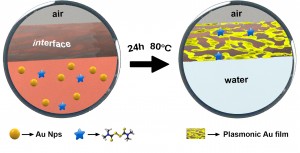Spontaneous Formation of Cold-Welded Plasmonic Nanoassemblies with Refracted Shapes for Intense Raman Scattering
Andrea Mariño-López, María Blanco-Formoso, Leonardo N. Furini, Ana Sousa-Castillo, Ecem Tiryaki, Moisés Pérez-Lorenzo, Martín Testa-Anta, Verónica Salgueiriño, Nicholas A. Kotov, Ramon A. Alvarez-Puebla, and Miguel A. Correa-Duarte
Langmuir 2019, 35, 4110‒4116
Nanostructures with concave shapes made from continuous segment of plasmonic metals are known to dramatically enhance Raman scattering. Their synthesis in solutions is hindered, however, by their own thermodynamic instability due to large surface area and high curvature of refracted geometries with nanoscale dimensions. Herein we show that nanostructures with concave geometries can spontaneously form by self-organization of gold nanoparticles (NPs) at air-water interface. The weakly bound surface ligands on the particle surface make possible their spontaneous accumula-tion and self-assembly at air-water interface forming monoparticulate films. Upon heating to 80 0C, the NPs fur-ther assemble into concave nanostructures where NPs are cold-welded to each other. Furthermore, the nanoassemblies effectively adsorb molecular analytes during the migration from the bulk solution to the surface where they can be probed by laser spectroscopies. We demonstrate that these films with local concentration of analytes increased by orders of magnitude and favorable plasmonic shapes can be exploit-ed for the surface enhanced Raman scattering (SERS) for high-sensitivity analysis of aliphatic molecules.








